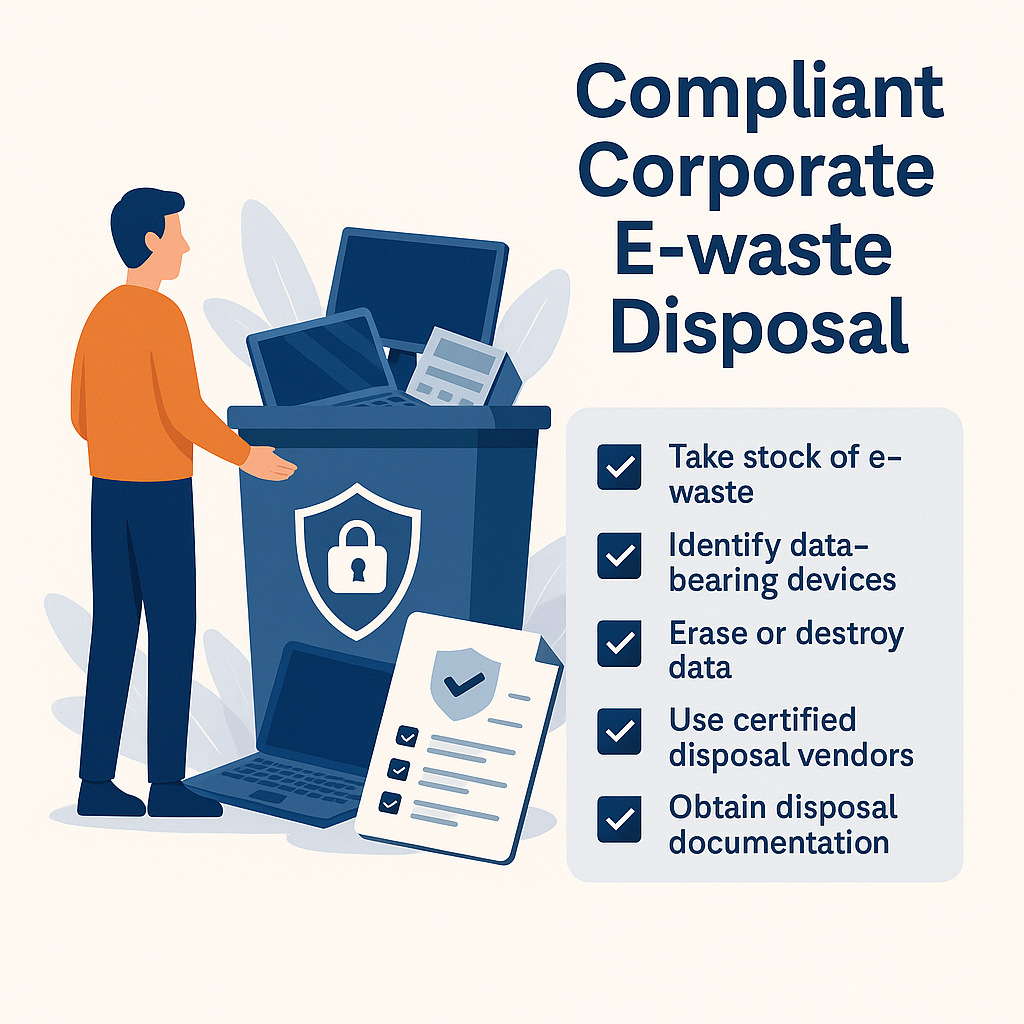Disposing of electronic waste (E-Waste) is more than a matter of logistics for Singaporean businesses. With strict regulations under the Resource Sustainability Act and data protection obligations under the Personal Data Protection Act (PDPA), companies must handle the end-of-life process for IT assets and electronic devices with care.
Failure to manage E-Waste properly can lead to environmental damage, regulatory non-compliance, and data breaches. This guide will help outline a professional, compliant, and responsible approach to corporate e-waste disposal in Singapore.
Step 1: Identify What E-Waste You Have
Not all companies have a detailed inventory systems, and that’s fine. The key is to be aware of the electronic equipment you’re planning to dispose of, starting with what’s visible in the office or store room:
- Laptops, desktops, monitors
- Servers, network switches, and routers
- Printers, copiers, mobile devices
- Storage devices (HDDs, SSDs, etc.)
If possible, take note of serial numbers or working condition. Even a simple list can be useful when coordinating disposal.
Step 2: Know Which Devices Contain Data
Not all devices hold data. Classifying them this way makes it easier to determine which items need secure handling:
- Data-bearing devices: Laptops, desktops, servers, mobile phones, external drives, and printers with internal storage
- Non-data devices: Monitors, keyboards, mouse, phones etc.
Focus your data protection measures on the items that store sensitive information.
Step 3: Choose a Suitable Data Destruction Method
To comply with PDPA guidelines, organisations must ensure personal data is irreversibly destroyed before disposal.
- Data erasure (software-based): For reusable devices. Should comply with international standards such as NIST 800-88.
- Physical destruction: Required for faulty or high-security drives. Includes shredding or degaussing.
Request a Certificate of Erasure or Destruction to maintain audit readiness.
Step 4: Appoint a Licensed E-Waste Disposal Partner
Select a service provider that is:
- Licensed by NEA for e-waste handling
- Experienced in handling business IT assets
- Able to provide secure transport and chain-of-custody documentation
While certifications like ISO 9001, ISO 14001, and bizSAFE3 are not mandatory, they reinforce credibility and process quality.
Step 5: Ensure Secure Collection and Transport
The collection stage carries a high risk of data exposure. Ensure the provider offers:
- GPS-tracked vehicles
- CCTV-monitored handling facilities
- Tamper-proof bins or containers
- Sign-off and documentation for every item collected
This will ensure compliance and peace of mind.
Step 6: Verify Responsible Recycling Practices
Disposal must be environmentally responsible. Verify that your vendor:
- Segregates hazardous components
- Partners with downstream recyclers
- Follows proper recovery protocols for metals and plastics
- Provides recycling reports upon request
This supports your company’s sustainability goals and CSR efforts.
Step 7: Maintain Disposal Records for Compliance
Always retain documentation such as:
- Disposal reports and recycling statements
- Certificates of Destruction or Erasure
- Chain-of-custody logs
These documents support PDPA audits and internal IT asset lifecycle reviews.
Corporate E-Waste Disposal Checklist:
Get Approval
□ Get approval before disposing of ANY company equipment
List All Equipment
□ Write down everything you need to dispose of
□ Note serial numbers and asset tags
□ Take photos
Identify Data Risk Level
□ HIGH RISK: Computers, servers, phones with company data
□ LOW RISK: Monitors, keyboards, mouse
*Ask IT if unsure
Find Approved Disposal Company
□ Get company’s approved vendor list from manager
□ Verify they have NEA license
Schedule Secure Pickup
□ Book pick-up when you can be present
□ Prepare equipment in secure area (ideally with CCTV monitoring)
□ Get signed receipt with all item details
Choose Data Destruction Method
□ Working devices: Ask for “data wiping”
□ Broken/sensitive devices: Ask for “physical destruction”
□ Request for certificate of destruction
Get Documentation and File Records
□ Receive certificates within 1-2 weeks
□ Check all serial numbers are listed
□ File certificates safely
□ Update company asset records
A structured and compliant approach to e-waste disposal helps your business avoid legal pitfalls, protect sensitive data, and contribute to environmental sustainability. In Singapore, it also signals professionalism and corporate responsibility.
For guidance on NEA-licensed disposal services, secure data wiping, or certified physical destruction, do consult a trusted IT asset disposal provider familiar with local regulations and audit requirements.

